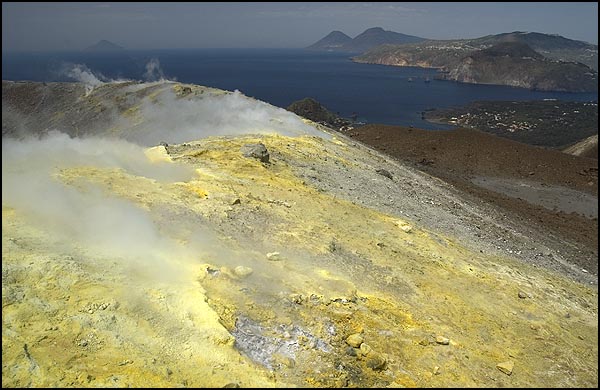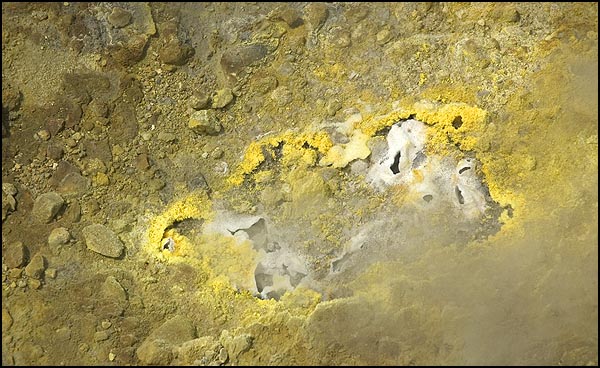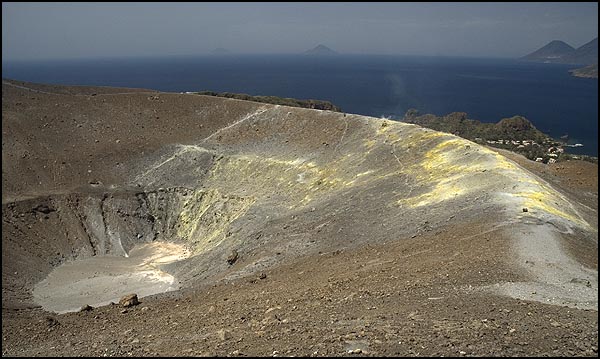|
Visit one from
the most beautiful places in Southern Mediterranean, one from
Eolian Islands, called "Vulcano" (named after the
Roman god of Fire - Vulcanus). Although dangerously dormant
for over 100 years now, it must have been highly active in Ancient
times. Vulcano is mostly known for its hot springs and
famous mud pools on the beach, allegedly having beneficent effects
on your health. The other main attraction on the island is the
large crater of La Fossa - the type example of a volcanic
crater. Hot, sulphur steam belching fumaroles align the rim of its
crater and are equally impressive.
Geologically, Vulcano is a complex
of overlapping edifices, including two calderas, that have formed
during the past ±150 000 years. The northern tip of the island is
lava platform that forms a low, roughly circular peninsula called
Vulcanello that was formed as an island beginning in 183 B.C. and
later was connected to Vulcano in about 1550 A.D. It is one of
Italy's most active volcanoes, and one with a high hazard
potential. During the historical period, the Fossa cone and
Vulcanello have been the site of frequent and vigorous eruptions,
the most recent of which occurred in 1888-1890 at the Fossa. More
recently, the Gran Cratere of the Fossa cone has been the site of
volcanic unrest (most notably, an increase of the fumarolic
activity) which began around 1985 and ended in 1995 without
culminating in an eruption. This episode of unrest has triggered
increased public awareness about the volcanic risk at Vulcano, and
intense studies of the volcano and its behavior. Geological studies
have shown that most eruptions of the Fossa cone have been
violently explosive and produced pyroclastic flows. The close
proximity of the village of Vulcano Porto therefore warrants timely
warning to all people in the area in case of renewed eruptive
activity.

On the coordinates you can see a
beautiful fumarole field. Fumaroles are vents from which
volcanic gas escapes into the open atmosphere. Fumaroles may occur
along tiny cracks or long fissures, in chaotic clusters or fields,
and on the surfaces of lava flows and thick deposits of pyroclastic
flows. They may persist for decades or centuries if they are above
a persistent heat source or disappear within weeks to months if
they occur atop a fresh volcanic deposit that quickly cools.
Fumaroles on La Fossa crater emite mixture of carbon dioxide,
sulphur dioxide and hydrogen sulphide. Sulphur dioxide and hydrogen
sulphide react together creating bright yellow layers of elementar
sulphur around the fumarole vents. These fumaroles are also called
solfatares (the name is derived from the Italian
solfo, sulfur).


Be careful! The vivid stench of
sulfur dioxide is toxic gas, and it is advisable to stay as briefly
as possible out of the plume. Prolonged stays in the plume may lead
to undesirable effects, such as the loss of the sense of smell.
For the
valid "cache found" log you have to send us via e-mail answers
to these three questions: a) check one from many fumaroles and try
to "measure" the diameter of gas emitting edifice; b) what is
(approx.) altitude of the fumarole field?; c) what (yellow!!)
mineral was mined here in the past?
|